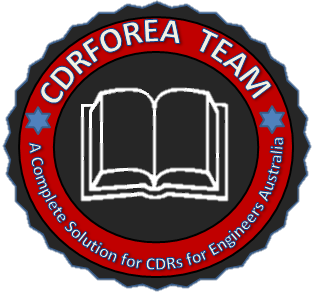If you’re an engineer planning to migrate to Australia, the first hurdle is always the Engineers Australia (EA) Skill Assessment. This formal evaluation – officially called a migration skills assessment – ensures your overseas engineering qualifications, experience and English ability meet Australia’s professional standards. You must pass this assessment before applying for any skilled visa (such as the Skilled Independent subclass 189, Skilled Nominated 190, or Skilled Work Regional 491). In practice, Engineers Australia is authorised by the Department of Home Affairs to assess your credentials and issue an outcome letter for migration purposes. Only with a positive EA outcome can you claim skill points and proceed with a visa application. This guide breaks down what the EA Skill Assessment involves, who needs it, how to prepare a strong application, and common pitfalls to avoid on the way.
What is the EA Skill Assessment?
The EA Skill Assessment (also known as the Migration Skills Assessment) is a detailed review of your engineering background conducted by Engineers Australia. Its purpose is to confirm you meet the “entry to practice” competencies expected of Australian engineers. In practical terms, EA checks your academic transcripts, degree certificates, and work history to see if they align with Australian standards for your nominated occupation. For many migrants, this involves submitting a Competency Demonstration Report (CDR), which consists of personal project write-ups and evidence of continued learning. EA’s role is purely technical: they verify your engineering knowledge and proficiency, but do not award migration points or give visa advice. After you submit your documentation, EA will email you a skills assessment outcome letter – either a positive approval or a rejection notice – which you then use for your visa application.
Key point: Engineers Australia’s skill assessment is the official stamp you need to migrate as an engineer. You cannot proceed with a skilled visa without this outcome letter.
Why is the EA Skill Assessment Required?
Australia maintains high standards for engineering practice to protect public safety and ensure quality. The skill assessment is how the Australian government enforces those standards for migrants. By evaluating your credentials, Engineers Australia checks that you have:
-
Proper technical training: Your degree must demonstrate coverage of essential engineering subjects. EA will confirm it meets the curriculum requirements (especially if it’s from abroad).
-
Professional competence: Your CDR (if required) shows how you’ve applied engineering methods and solved problems in real projects.
-
English proficiency: You must show you can communicate well in English. In most cases that means achieving at least IELTS 6.0 (or equivalent TOEFL/PTE) in each skill.
-
Global engineering standards: If your country is not a signatory to the Washington/Sydney/Dublin accords, the CDR path ensures you meet Australian engineering practice standards.
In short, the EA assessment protects Australia from under-qualified practitioners. It’s also the government’s way to ensure fairness: everyone, regardless of where they studied, is held to the same competency benchmarks. You’ll need to pass this assessment before any visa can be granted. As EA notes, “You’ll need a migration skills assessment outcome letter from us before you can apply for a visa to come to Australia.”
Who Needs an EA Skill Assessment?
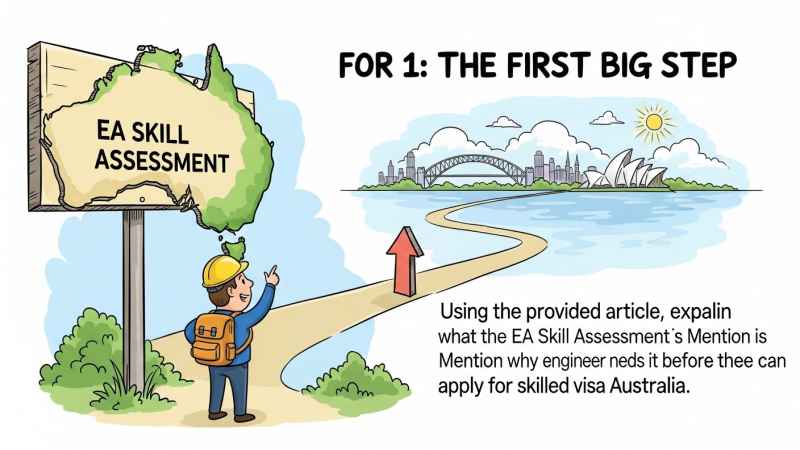
All engineers seeking skilled migration to Australia will need an EA assessment if their qualifications fall outside Australia’s accredited systems. In practice, you likely need an assessment if:
-
Your degree was earned overseas. If you completed your engineering qualification outside Australia, you typically must have it assessed by EA. For example, engineers from India, Pakistan, Bangladesh, Nepal, Sri Lanka, the Philippines or most Middle Eastern countries will need to apply via EA. These countries are not signatories of the Washington/Sydney/Dublin accords, so their degrees are considered non-accredited.
-
Your country is not in the Washington/Sydney/Dublin accords. If your country is a full signatory (like the USA, UK, Canada, NZ, Japan, etc.), and you graduated after accreditation began, you may qualify under the relevant accord pathway. If not, you must use the CDR route.
-
You have a non-accredited qualification. Even in Australia, some engineering diplomas or associate degrees may not be accredited by EA. In that case, EA treats them as non-accredited and requires a full competency assessment.
-
You want to change your nominated occupation. If your accredited degree is in one field but you are applying for a different engineering occupation, EA may require you to prove competency via CDR.
-
Your qualification is provisionally accredited. If you hold a provisional or conditional Australian engineering degree (e.g. an Associate Degree or Advanced Diploma), EA may also route you through the CDR pathway.
For all the above cases, the Competency Demonstration Report (CDR) pathway is the answer. In the CDR pathway, you submit detailed evidence of your engineering projects and skills so EA can assess you directly.
Covered occupations: EA evaluates all key engineering roles on Australia’s skilled lists. This includes categories like Professional Engineers (civil, mechanical, electrical, industrial, telecommunications, etc.), Engineering Technologists, Engineering Associates, and Engineering Managers. You should verify that your ANZSCO occupation code appears on the relevant Skilled Occupation Lists for the visa you want. Popular codes include Civil Engineer (233211), Mechanical Engineer (233512), Electrical Engineer (233311), Electronics Engineer (233411), Telecommunications Engineer (263311), and Engineering Manager (133211), among others. (Home Affairs publishes the official lists for subclass 189, 190, 491, etc.) Only occupations on these lists can be nominated in your application.
EA Skill Assessment Pathways
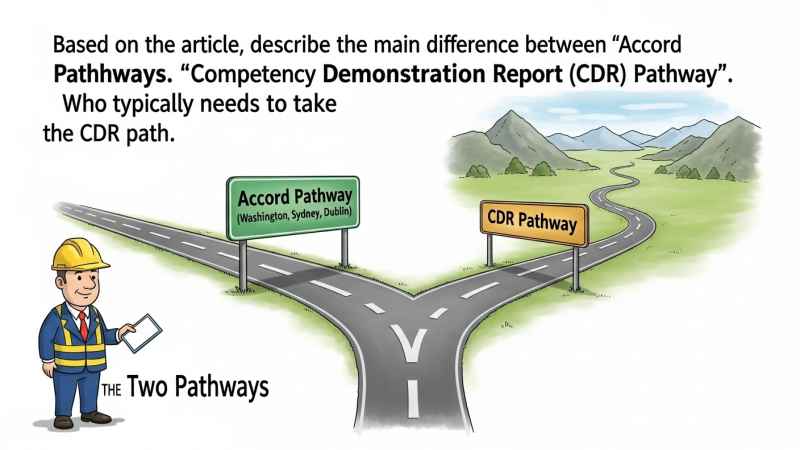
Engineers Australia offers different assessment pathways depending on your qualification. Here’s how to tell which path is right for you:
-
Australian Qualifications Pathway: If you have a fully accredited Australian engineering degree (listed in EA’s accredited programs) that was started during or after its accreditation year, you can apply under the Australian pathway. The fee is lower for this pathway because EA can rely largely on your accredited degree. Note: as of Sept 2024, EA limits this to degrees accredited by EA itself, not just any RTO diploma.
-
Washington Accord (Professional Engineer) Pathway: If your bachelor’s (or higher) degree comes from a country that is a full signatory of the Washington Accord and the degree started after the country joined, EA accepts it without a CDR. Washington Accord signatories include the USA, UK, Canada, Ireland, HK, Japan, S. Korea, Malaysia, Singapore, China (Beijing), Turkey, and (as of 2023) Mexico, among others. Under this path, the assessment focuses on your qualification and any work experience.
-
Sydney Accord (Engineering Technologist) and Dublin Accord (Engineering Associate) Pathways: These work similarly for degrees in technologist/associate categories. If you have a degree from a Sydney Accord country (technologist category) or Dublin Accord country (associate category), you may qualify for those occupational categories.
-
Competency Demonstration Report (CDR) Pathway: If none of the above apply, you must submit a CDR. In practical terms, use the CDR pathway if your qualification is not accredited (or from a non-Accord country), if it is only provisionally accredited, or if you’re being assessed in an occupation different from your degree title. Under the CDR pathway, EA will review your written Career Episodes, Summary Statement, CV, and other evidence to judge your competency.
According to Engineers Australia, “If your qualification is not accredited or it is from a non-Accord listed country, you’ll need to complete a migration skills assessment (CDR)”. In other words, the CDR path covers all non-accredited applicants. During the online application, you will choose your nominated engineering occupation from EA’s dropdown (currently about 31 occupations are listed). After a successful CDR, your official outcome letter will state both the occupational category (Engineer/Technologist/Associate/Manager) and the specific ANZSCO occupation.
Note: Accreditation is about programs, not individuals. Even if you have the right degree title, EA will check if your specific program was accredited during your graduation year. You can use the International Engineering Alliance’s online qualification checker to confirm if your degree is accredited under Washington, Sydney or Dublin Accord.
What is a Competency Demonstration Report (CDR)?
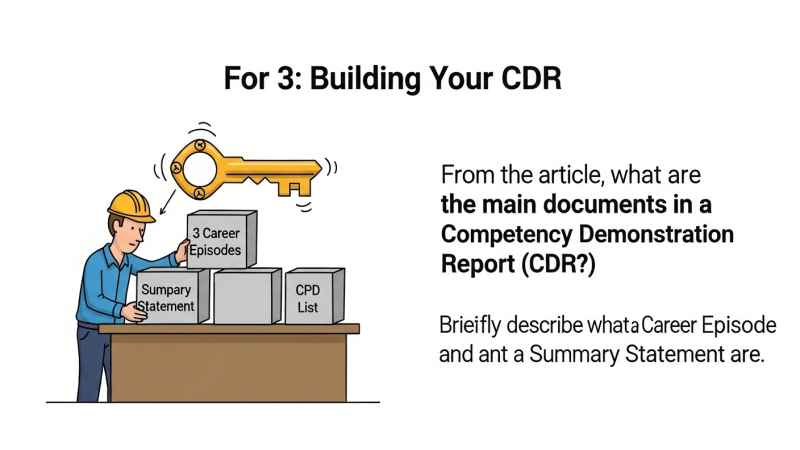
The CDR is the core of the skill assessment for many overseas engineers. It is essentially a set of narrative documents you prepare to demonstrate your engineering competency. According to EA, a CDR is “a combination of customised documents used by Engineers Australia to assess the competency of an engineer on the basis of engineering skills and knowledge, management, communication and leadership.” All engineers from non-Accord countries or with unaccredited degrees must submit a CDR as their Stage 1 skills assessment.
A complete CDR submission includes:
-
Three Career Episodes: Each episode is a 1,000–2,500 word essay about a project or work activity you carried out. You should write in the first person (“I did this…”) and explain your specific role in the engineering task. Use an engineering approach – define the problem, explain your design or solution, show how you implemented and evaluated it. Be sure to highlight the particular engineering competencies you used (like analysis, design, problem-solving, teamwork, etc.). According to EA guidelines, “Each career episode should be between 1000 and 2500 words”, and must include details like project dates, location, your job title, employer name, and a narrative of what you personally did and learned. If you’re a recent graduate with little work history, you may use a significant university project or internship – but even then, emphasize your own contribution to the team result.
-
Summary Statement: This is an Excel (or web) template where you map the 16 competency elements (for your occupational category) to specific paragraphs in your Career Episodes. You identify where in your episodes you have demonstrated each competency. EA uses this to quickly check off that all required elements (PE1–PE3, etc.) are covered at least once. The Summary Statement must be very precise: each competency bullet is cross-referenced to numbered paragraphs in your episodes.
-
Continuing Professional Development (CPD): A list (usually bullet points) of any courses, workshops, seminars or training you’ve done to keep your engineering skills up-to-date. There’s no strict format, but include technical conferences, certifications, short courses, published papers, or even online courses that relate to your field. This shows EA that you are engaged in lifelong learning as an engineer.
-
Curriculum Vitae (CV): Your updated resume, detailing all your education, employment history, technical skills and achievements. The CV should line up with your Career Episodes and contain the same employment dates. EA expects a professional, chronological CV, though they do not score it directly.
-
Supporting Documents: These include official degree certificates and transcripts (with certified English translations if needed), passport bio-page, ID photo, employment letters or appointment letters, and proof of English test results. You will upload these as part of your application.
In summary, the CDR is the EA Skill Assessment for many applicants. You must show clear engineering evidence in your writing. As one guidance note explains, you should “define, plan and design, deliver, [and] evaluate” your tasks, and detail how you solved problems and applied your technical knowledge. The narratives must be original – your own work and writing. (Engineers Australia explicitly checks for plagiarism: copying from other sources or another CDR will get you rejected.) Your Career Episodes are by far the most critical part of the CDR; they must be written in clear English and give enough technical detail to satisfy the competencies.
Required Documents and English Test
Before you apply, gather all necessary paperwork. At minimum, Engineers Australia will require:
-
Personal Identification: A scanned copy of the bio-data page of your passport (with photo and name) and a recent passport-sized photograph. If your name has changed, include legal documentation (marriage certificate, deed poll, etc.).
-
English Language Evidence: If you do not hold an Australian/New Zealand/UK/US/Canada/Ireland passport or degree, you must show proof of English proficiency. EA accepts the following tests (taken within the last 2 years):
-
IELTS (Academic or General): minimum 6.0 in Listening, Reading, Writing, and Speaking.
-
TOEFL iBT: minimum 12 (Listening), 13 (Reading), 21 (Writing), 18 (Speaking).
-
PTE Academic: minimum 50 in each of Listening, Reading, Writing, and Speaking.
-
These are the minimum scores required by EA. (Anyone holding an Australian bachelor’s degree or similar from an English-speaking country may be exempt.) For clarity, here are the scores in table form:
Table: Minimum English test scores accepted by EA.
-
Academic Records: Bachelor’s and master’s degree certificates (if applicable) and complete academic transcripts (mark sheets). If any documents are not in English, you must provide certified translations. Ensure that your transcripts list all subjects and grades – EA will cross-check them against your degree.
-
Employment Evidence: For any work experience you claim, provide supporting documents such as employment appointment letters, experience letters on official letterhead, pay slips or tax records. These prove the dates and roles you describe in your CV and Career Episodes. (For CDR applicants, the letters should explicitly mention your job duties and dates.)
-
Curriculum Vitae (CV): A detailed resume in reverse-chronological order listing your education and work. It should align with the projects you describe in your Career Episodes.
-
CDR Documents: If required by your chosen pathway, prepare your three Career Episodes, Summary Statement and CPD list as per EA’s rules.
Once gathered, all documents must be uploaded electronically in the EA portal (MyPortal) during your application. Incomplete or incorrect documentation is a common cause of delays or rejection, so double-check that everything is clear, certified (if needed), and legible.
Step-by-Step: How to Apply for the EA Skill Assessment
The application process for an EA Skill Assessment is done entirely online via Engineers Australia’s myPortal. Here’s a roadmap of the key steps:
-
Check Your Qualifications and Occupation: First, confirm that your engineering degree and occupation are eligible. Use the International Engineering Alliance’s qualification checker to see if your degree is accredited under Washington/Sydney/Dublin. Check the Skilled Occupation Lists on the Home Affairs website to make sure your ANZSCO occupation is in demand. Also review EA’s accredited program list (available on their website) if you studied in Australia. If your qualification is fully accredited, you may not need a CDR. Otherwise, plan on the CDR pathway.
-
Gather Documents: Collect all the required paperwork described above (passport, degrees, transcripts, CV, employment letters, English test results, etc.). Make copies and get translations done early. According to EA, you’ll need personal ID, an updated resume, degree certificates, academic transcripts, and proof of English proficiency. It’s wise to arrange these well before applying because some items (like English tests) can take weeks.
-
Prepare Your CDR (if needed): If you’ll use the CDR pathway, begin writing your Career Episodes, Summary Statement and CPD. Follow EA’s official guidelines: write in first person, focus on your own role, and address all competency elements. Keep each Career Episode between 1000 and 2500 words. Be ready to reference EA’s CDR Booklet while writing. If you’re doing it yourself, allow several weeks for drafting and revision. If you hire a service, allow time for their work.
-
Create an EA Portal Account: Go to Engineers Australia’s website and create a MyPortal account. EA will email you an Account ID after registration. (Note: keep this ID – you’ll use it to log in.)
-
Submit Your Application: Log in to the EA portal, navigate to the Migration Skills Assessment section, and start a new application. You will select your assessment type (e.g. CDR pathway). Upload all scanned documents, fill in your details, and attach your written reports (Career Episodes, etc.) if applicable. The portal is user-friendly, but refer to EA’s online application guide if you need help.
-
Pay the Assessment Fee: Pay the required fee online. For a CDR assessment in 2025, the base fee is about AUD 1,001 (including GST). If you’re on an Australian or Accord pathway, the fee is lower (see table below). You can also choose fast-track for an extra fee (explained below).
-
Wait for Confirmation and Outcome: After submission, you’ll get an email confirming receipt. Your application will be queued and eventually assigned to an assessor (standard wait is ~15 weeks). EA may request additional information if needed. Monitor your portal dashboard or email for updates. Once a decision is made, EA will email your outcome letter, which you should download and keep safe.
Each of these steps should be completed thoroughly. Remember that “the online application is easy to follow,” but the quality of your documents ultimately determines the outcome. Allow plenty of time for writing, reviewing and double-checking everything.
Processing Time and Fees
Engineers Australia provides two processing options:
-
Standard Assessment: Once you submit, it generally takes about 15 weeks for your case to be assigned to an assessor. This does not mean you will get your result in 15 weeks; it’s just the initial wait time to assignment. After assignment, time to final outcome depends on the completeness of your application and any queries that arise.
-
Fast-Track Service: For an extra fee, you can get priority handling. EA promises assignment to an assessor within 20 business days for fast-track applications. (Note: “assignment” means it’s assigned to an assessor quickly; the final decision may still take longer.) The fast-track additional fee is AUD 385 (incl. GST), on top of the base assessment fee.
Here is a summary of EA’s 2025–26 fees for migration skills assessment (inclusive of GST):
Table: Engineers Australia migration skills assessment fees (2025–26).
Always check EA’s website before applying, as fees can change. When you pay, you’ll receive a payment confirmation. After that, use your portal to Submit the application (don’t forget this final step).
Receiving Your Outcome
Once the assessment is complete, EA will issue you a Migration Skills Assessment Outcome letter via email. This official letter will state whether your skills were assessed as suitable. If successful, it will list your occupational category (e.g. Professional Engineer) and nominated engineering occupation.
Importantly, Engineers Australia’s outcome letters do not expire. EA itself considers the letter valid indefinitely for their purposes. However, for visa applications, the Department of Home Affairs usually treats a skills assessment as valid for 3 years from the date of issue (in case the EA letter is more than 3 years old, HO will only count it as 3 years valid). In practice, plan to apply for your visa well within three years of your EA assessment to avoid issues.
Once you have your positive assessment letter, you can lodge your visa application and claim points for your engineering qualification. Keep a digital copy and print it out – you will need to submit it with your visa papers. You can always verify the authenticity of your outcome letter by logging into the EA portal.
Common Mistakes and CDR Rejections
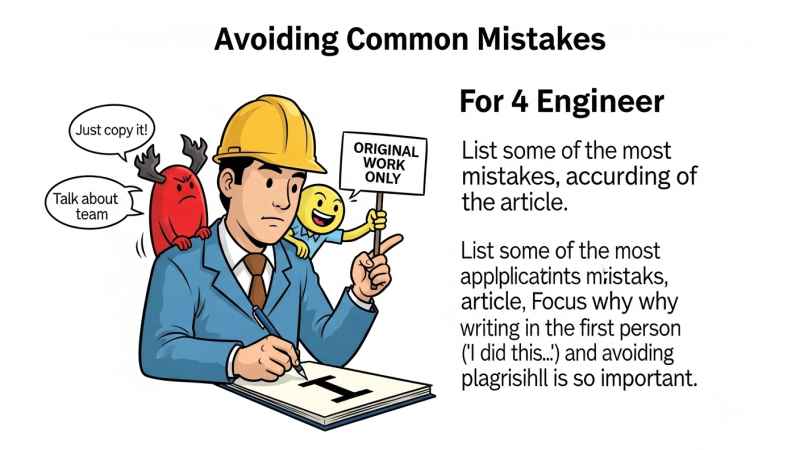
Many applicants fall short not because they lack qualifications, but due to avoidable errors in their CDR or documents. Some frequent pitfalls include:
-
Copied or Plagiarized Content: EA uses plagiarism detection on CDRs. Any text taken from the internet or a previously submitted report will be flagged. As one CDR writing guide warns, the main causes of rejection include “copied content from internet sources” or from another CDR. Always write original text, and never reuse Career Episodes from someone else.
-
Focus on Teamwork Instead of Individual Role: Career Episodes must be written in the first person, emphasizing your contributions. A common error is to write about the team or company’s achievements rather than “I designed this solution” etc. EA expects paragraphs like “I calculated… I designed… I implemented…”. If you worked in a team, clearly state what you personally did to contribute.
-
Incomplete or Poorly-Structured Episodes: Not addressing the engineering competencies explicitly leads to failure. EA requires that all 16 competency elements be “demonstrated at least once”. If your episodes are vague or lack technical detail, your Summary Statement cannot properly map to the requirements. Always cross-check EA’s MSA Booklet and sample competency elements to ensure your episodes cover everything.
-
Grammatical Errors and Weak English: Remember the assessors are also checking communication skills. Poor grammar, spelling mistakes or unclear writing can hurt your credibility. Make sure your writing is clear and in proper English (seek proofreading help if needed).
-
Missing or Incorrect Documents: Omitting a required document (like an academic transcript or English test certificate) can lead to immediate delays or rejection. Submit all requested evidence. If translations are needed, they must be certified. Incomplete documentation means EA may keep asking for more, slowing down your assessment.
-
Summary Statement Errors: The Summary Statement must precisely reference the paragraphs in your Career Episodes where each competency element is demonstrated. Using the wrong paragraph numbers, or not explaining how you met a competency, will cause failure. Number your paragraphs in each episode (as EA advises) so you can cross-reference easily.
Avoiding these mistakes is crucial. As one CDR resource notes, “if your career episodes are deficient, your summary statement automatically becomes deficient”. Careful planning, original writing, and thorough review can save you from a rejection.
How Professional Services Can Help
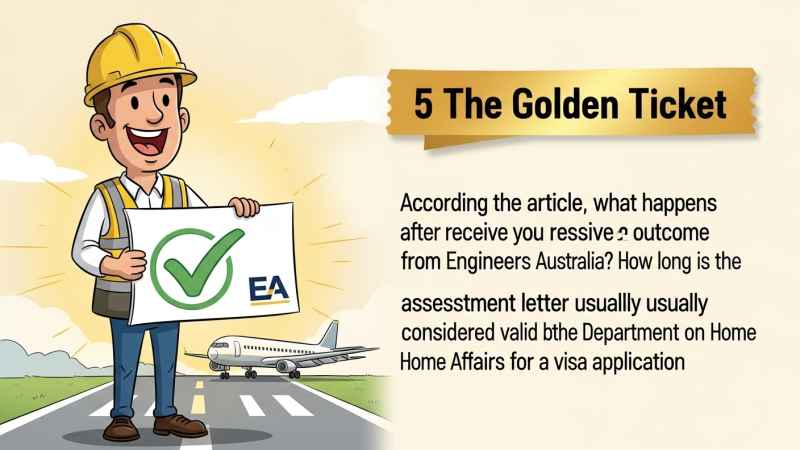
Because the EA Skill Assessment (especially the CDR pathway) is so involved, many candidates choose to use professional writing and review services. These CDR Skill Assessment specialists can save time and improve your chances by doing things like:
-
Full CDR Writing: They can write your Career Episodes, Summary Statement and CPD from scratch (based on interviews or project information you provide).
-
Editing and Proofreading: If you draft your own CDR, a professional can polish the language, correct grammar, and ensure all competencies are addressed.
-
Review and Feedback: They check for compliance with EA’s rules, fix any structural issues, and flag missing content.
-
Plagiarism Checking: They ensure the text is 100% original to avoid EA’s plagiarism filter.
-
Document Preparation: Some services also help organize and present your documentation (CV, letters, etc.) according to EA’s guidelines.
-
Fast Turnaround: Experienced teams often complete or review a CDR within a few days, much faster than an individual working alone.
For example, one CDR writing company advertises having “domain specific writers from all the engineering sectors” and guarantees unique, high-quality content. They even offer a money-back guarantee if EA rejects your report, highlighting the confidence in their success rate. While you must be cautious in selecting any service (preferably one with verifiable testimonials), such assistance can be worthwhile for avoiding the common pitfalls above.
(Note: using a paid service does not guarantee success – the content still must be factual and your own experience. But professional help can reduce errors and stress.)
FAQs About EA Skill Assessment
Can I write my own CDR?
Yes, many applicants prepare their own CDR. It’s allowed so long as the content meets EA’s requirements. However, you must thoroughly understand EA’s Migration Skills Assessment (MSA) booklet and have enough time to research and write. Engineers Australia itself notes that you can self-prepare your CDR if you have the necessary project experience and know the guidelines. In practice, writing it yourself is a big task. If you choose this route, use EA’s official resources and samples, and consider having someone review your final draft.
How long is an EA Skill Assessment valid?
According to Engineers Australia, the outcome letter is valid indefinitely for their purposes. In other words, EA won’t cancel the letter after a certain time. However, for visa applications, the Department of Home Affairs typically treats any skills assessment result as valid for only three years from the date of issue. Therefore, plan to apply for your Australian visa within three years of getting the EA letter to avoid any issues.
How many words should each Career Episode have?
EA specifies that each Career Episode should be between 1,000 and 2,500 words. Stick to this range. Writing significantly less may not cover enough detail, while writing much more can be repetitive. Focus on concise, relevant storytelling of your engineering work.
Can I reuse someone else’s CDR?
Absolutely not. Reusing any text from another person’s CDR or any published source will be detected as plagiarism. EA and migration authorities take originality very seriously. If Engineers Australia finds duplicated or copied content, your CDR will be immediately rejected. Always write your own report.
Do I need work experience to apply?
Work experience strengthens your CDR, but it’s not strictly required if you’re a fresh graduate. EA explicitly allows recent graduates to use academic projects or design work from university as their Career Episodes. If you lack paid employment, choose significant college projects or internships for your episodes. Just be sure to explain your own contribution to the project. In summary, having real job experience can make your CDR more convincing, but students without formal work can still prepare a valid CDR based on their coursework projects.
Final Thoughts
The EA Skill Assessment is the crucial first step on the path to becoming an engineer in Australia. It may seem daunting at first glance, but with proper preparation you can meet the challenge. Start early: check your eligibility, gather documents, polish your English, and if necessary invest time in writing a strong CDR. Pay close attention to Engineers Australia’s official guidelines and formatting rules.
If you get stuck, remember that experts and paid services are available to assist. A good CDR-writing service can help you avoid common errors, format your documents correctly, and give you confidence that your application meets EA’s standards. For example, services like CDRforea specialize in CDR Skill Assessment assistance and can work with you to create a professional, compliant submission. They typically offer editing, plagiarism checks and a guaranteed structure aligned with EA’s requirements.
Ultimately, the more thorough and honest your application, the better your chances of approval. Passing the EA Skill Assessment brings you one step closer to living and working in Australia. Good luck, and take advantage of the resources available – the effort you put in now will pay off when you earn that skills assessment outcome letter and move on to your visa application.
